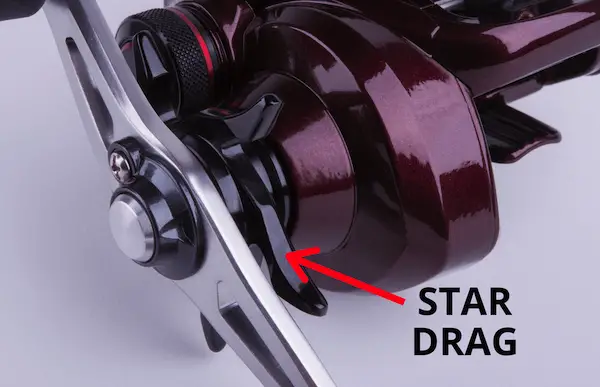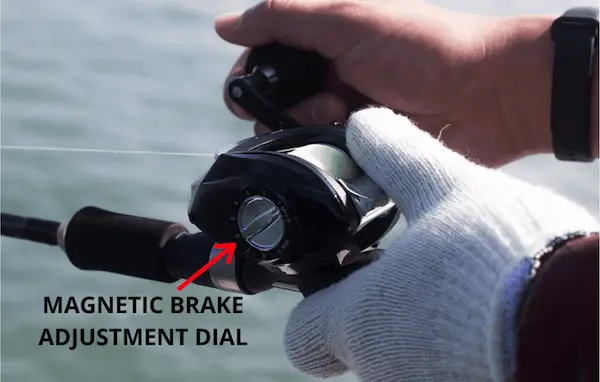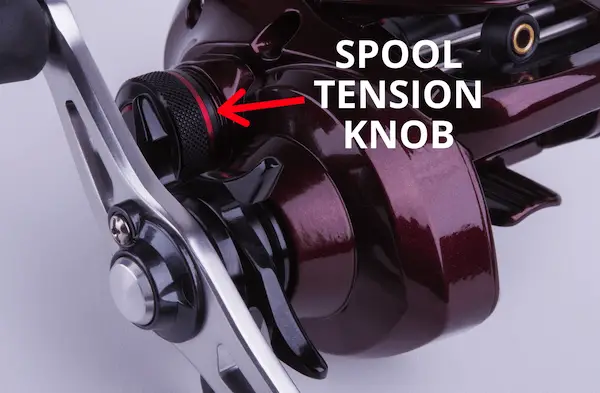What are the parts of a baitcaster reel, and what do they do?
UPDATED 08 MAY 2023
by Robert Ceran
Baitcasting reels are very popular among anglers, due to the fact they have greater casting accuracy and distance compared to other types of fishing reels, most notably spinning reels.
In addition to better casting performance, baitcasters also tend to be more lightweight than spinning reel sizes that are comparable in term of line capacity.
So, if you are keen to leverage the impressive advantages offered by baitcasters, the first thing you need to do is understand the baitcaster parts and what they do.
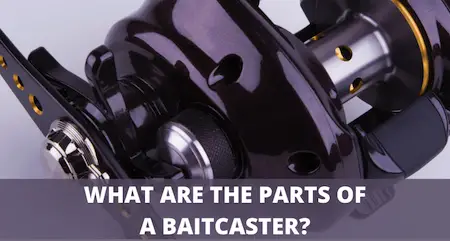
In this baitcaster guide we’ll show you the most important baitcasting reel parts and explain their function.
We’ll also help you understand how to use them, and what to look for in a high quality baitcaster.
Baitcaster reel parts explained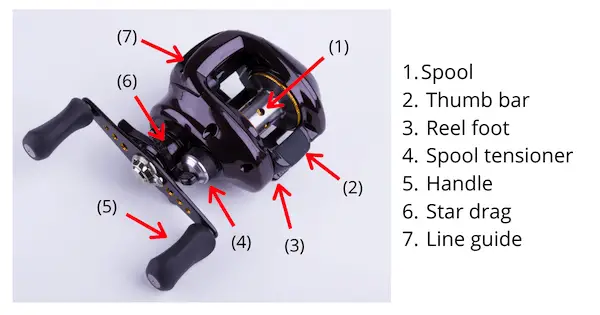
Spool
The baitcaster spool is housed inside the reel frame, but is open in the middle.
One of the key characteristics of baitcasting reels is that the spool rotates when you turn the handle. This serves to spool the line on to the reel, and thus to retrieve your lure.
This mode of operation is in contrast to spinning reels, where a bail arm wraps line around a stationary spool that doesn’t rotate.
Refer to our guide on how to spool a baitcasting reel in order to put line on the spool correctly.
An essential feature that you need to master on baitcasting reels is controlling spool rotation during a cast.
When you cast with a baitcasting reel, the weight of your lure causes the spool to rotate, which essentially ‘unwinds’ the line during the cast.
The problem with this is that the spool continues to rotate rapidly even when the lure slows down and is about to hit the water, which can cause backlash and birds nest creation.
We’ll cover the different ways to control spool rotation in more detail below. You can start by spooling your baitcaster with line correctly, which helps to avoid backlash.
Reel foot
A baitcasting reel is attached to the rod via its foot. In the case of low profile baitcasters, the foot is recessed, and as a result the reel body nestles right on top of the rod, without sticking out.
This helps to make it extremely ergonomic, and easy to handle for long periods of casting.
Unlike spinning reels, baitcast reels sit on top of the rod, facing the angler during the cast.
Make sure the reel foot is fastened tightly to the reel socket (also called reel seat) of the rod before you start fishing.
Star drag
The drag control of baitcasters is usually located right next to the handle, in the form of a star shaped knob between the handle and reel body, which is why it’s usually referred to as a star drag.
This configuration makes it very convenient and easy to adjust drag pressure when necessary, if you’re fighting a strong fish, for example.
If your drag system is set too loose, this will allow fish to pull line off your reel quite easily, which is a problem if you’re trying to steer them away from cover.
If the drag is set too tight, on the other hand, it’s possible that a strong fish can break the line. Because of this it’s essential to learn how to use the star drag knob to adjust the drag pressure as needed.
Braking system
A question I often get is, “what does the brake do on a baitcaster?”
The braking system is an essential feature of baitcasters, which helps to slow down spool rotation during the casting process in order to avoid backlash.
There are two types of baitcaster brakes: centrifugal and magnetic. Many baitcaster models nowadays have both of these braking systems, and both the centrifugal and magnetic brakes are essential slow down spool rotation during the initial part of your cast.
In order to adjust the centrifugal brakes, you have to remove the side panel of the reel, which is best done before you start fishing.
If you’re a beginner, we suggest setting the centrifugal brakes to maximum. Many baitcasters have 6 centrifugal brakes, and setting them to maximum would mean sliding all 6 to their active position.
If your baitcaster has magnetic brakes, these can usually be adjusted externally with a dial on the side of the frame (on the side of the reel which is opposite to the handle – see photo above).
If you’re a beginner, and not sure how much magnetic brake to use, turn the dial about half way and test how that works out for you.
Spool tension knob
The second way to adjust the speed of spool rotation is with the baitcaster spool tension knob, which is a round knob located on the same side as the reel handle.
Unlike the centrifugal and magnetic brakes, the spool tensioner slows down spool rotation more towards the end of the cast, when the lure is about to hit the water, and stops pulling line off the spool.
The spool tensioner serves to fine tune the spool rotation speed, so always start by adjusting the brakes first, and then move on to the spool tensioner.
An important detail to keep in mind is that lures of different weight will perform differently with respect to the spool tension. Because of this, you’ll need to re-adjust spool tension every time you change a lure.
Line guide
The line guide serves to ensure that the line is spooled on to the baitcaster spool evenly, by moving back and forth from one end of the spool to the other as you turn the handle.
Remember to thread the line through the line guide before you thread it through the guides of your baitcasting rod.
Thumb bar (clutch)
The thumb bar is used to release line when you cast your lure. When you press the thumb bar down, this puts the reel into free rotation by disengaging the gears from the spool.
You need to press the thumb bar at exactly the moment when you want to release the line during the casting process.
The great thing about this is that it positions your thumb close to the spool, which comes in very handy to slow down spool rotation manually during the cast.
Gear system
The gears of a baitcaster are housed inside the reel body, and serve to translate rotation of the handle into rotation of the spool.
Reel handle
The baitcaster reel handle differs from that of a spinning reel by having two knobs instead of one.
Usually the handle is quite large compared to the size of the reel body, and the knobs are made of ergonomic EVA foam or hard plastic.
Overall, baitcasters tend to be built for highly ergonomic handling and comfort of use, which is especially true for low profile baitcasters.
These lightweight reels nestle on top of the rod handle, and the big reel handle with thick knobs is a pleasure to hold while operating the reel.
What should you look for in a baitcaster?
If you understand how a baitcaster works, a great way to judge the quality of a baitcaster is by looking at the performance of its parts.
The specific features you’ll want to look for in a baitcaster depend on what application you’ll be using it for.
For example, if you plan to do lure casting for bass, the best choice would be a lightweight, low profile baitcaster with a relatively high speed gear ratio.
Also, you’ll want to choose a reel made of graphite, since it’s significantly lighter than aluminum.
If you’re specifically interested in lightweight applications, you may want to check out our review of the smallest baitcasting reel.
Here are the main features to look for in the parts of a baitcaster:
Low-profile vs round baitcaster
Low profile baitcasters: built for maximum comfort and lightness of weight. They have a small spool that nestles right on top of the handle of the rod, and tend to be much lighter than other models.
This makes them perfect for long hours of casting, which is why they are so popular for bass fishing.
Round baitcasters: round baitcasters have a large round spool that protrudes more from the rod compared to low profile reels. They also tend to be heavier.
The round spool has a bigger line capacity, which is great for applications with long distance casting (such as surf fishing, for example).
It also works well with stronger pound test line, which is helpful for catching bigger fish (such as catfish, for example).
Reel material
Baitcasters are usually made of 2 main types of materials: aluminum or graphite. Some reels use both of these in different proportions.
You need to be aware that aluminum is more durable than graphite, but also heavier.
Some anglers have reported that a baitcasting reel foot made of graphite can break under extreme stress, but personally I’ve never experienced this.
Also, since graphite is a lot lighter, it’s my preferred choice for situations where I’ll be casting a lot all day long.
If you’re planning to use your baitcaster for saltwater fishing, you should look for a strong aluminum reel that has been treated to make it resistant to saltwater corrosion.
Gear ratio
The gear ratio of a reel describes how many times its spool rotates when you turn the handle once. It is usually referred to with a number such as 6.1:1, or 8.0:1.
The number on the left side of the colon tells you how many times the spool rotates for every turn of the handle.
For example, a 7.1:1 gear ratio means that the spool rotates 7.1 times when you turn the handle once.
One advantage of baitcasters is that they tend to have higher gear ratios than spinning reels, which means you can retrieve the line more quickly.
Any baitcaster gear ratio above 7 is considered to be on the fast side.
Fast reels can be advantageous to pull strong fish away from cover before they can get snagged.
If you’re not sure if you’ll need a super fast reel, go for a gear ratio around 7.0:1, since this is in the middle of the range.
Slow reels have more torque, which can be helpful when you’re fighting big, strong fish.
Because of this, big game reels (which are basically super sized baitcasters), have two gears: a high gear for retrieving the lure, and a low gear for fighting the fish.
Brake system
Some baitcasters (mainly older models) only have one type of braking system, while others have both centrifugal and magnetic brakes.
We suggest that you look for a baitcaster with both a centrifugal and a magnetic brake that can be adjusted externally, via a dial on the side of the reel frame.
This will give you the maximum amount of braking effect, plus the greatest scope for adjusting the braking system, which will really help to avoid backlash during your casting.
Drag force
The drag of a baitcaster allows line to be pulled off the spool when a strong fish makes a powerful run, which helps to avoid line breakage.
The drag power of a reel refers to how much weight the drag can hold while still functioning smoothly.
For most purposes, a drag force of 7-12 pounds is plenty. Some reels have extra powerful drags up to 25 pounds drag force, which can be helpful for battling very big fish.
Conclusion
Compared to other fishing reels, baitcasters can seem a little intimidating at first, once you understand how the most important parts of a baitcasting reel work, you’ll be able to choose the best reel for your purposes, and will likely join the large group of anglers who swear by baitcasting reels.
You’ll also understand the differences between baitcasters vs spinning reels, since the parts of a spinning reel are quite different to those of baitcast reels.
And if you’re in the market for a new baitcaster, check out our article on the best baitcasting reel under $100.

